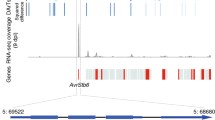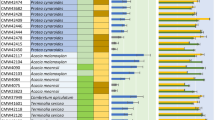Abstract
This study provides empirical evidence for antagonistic density dependence mechanisms driving sexual reproduction in the wheat fungal pathogen Zymoseptoria tritici. Biparental crosses with 12 increasing inoculum concentrations, in controlled conditions, showed that sexual reproduction in Z. tritici was impacted by an Allee effect due to mate limitation and a competition with asexual multiplication for resource allocation. The highest number of ascospores discharged was reached at intermediate inoculum concentrations (from 5 × 104 conidia mL−1 to 106 conidia mL−1). Consistent with these results for controlled co-inoculation, we found that the intensity of sexual reproduction varied with both cropping period and the vertical position of the host tissues in the field, with a maximum between 25 and 35 cm above the ground. An optimal lesion density (disease severity of 30 to 45%) maximizing offspring (ascospores) number was established, and its eco-evolutionary consequences are considered here. Two ecological mechanisms may be involved: competition for resources between the two modes of reproduction (decrease in the host resources available for sexual reproduction due to their prior use in asexual multiplication), and competitive disequilibrium between the two parental isolates, due to differential interaction dynamics with the host, for example, leading to an imbalance between mating types. A conceptual model based on these results suggests that sexual reproduction plays a key role in the evolution of pathogenicity traits, including virulence and aggressiveness. Ecological knowledge about the determinants of sexual reproduction in Z. tritici may, therefore, open up new perspectives for the management of other fungal foliar pathogens with dual modes of reproduction.











Similar content being viewed by others
References
Kokko H, Rankin DJ (2010) Lonely hearts or sex in the city? Density-dependent effects in mating systems. Philosophical Transactions in the Royal Society B 361:319–334
Lee SC, Ni M, Li W, Shertz C, Heitman J (2010) The evolution of sex: a perspective from the fungal kingdom. Microbiol. Mol. Biol. Rev. 74:298–340.3
Lively CM (2009) The maintenance of sex: host-parasite coevolution with density-dependent virulence. J. Evol. Biol. 22:2086–2093
Gascoigne J, Berec L, Gregory S, Courchamp F (2009) Dangerously few liaisons: a review of mate-finding Allee effects. Popul. Ecol. 51:355–372
Neiman M, Warren D, Rasmussen B, Zhang S (2013) Complex consequences of increased density for reproductive output in an invasive freshwater snail. Evol. Ecol. 27:1117–1127
Stelzer CP (2012) Population regulation in sexual and asexual rotifers: an eco-evolutionary feedback to population size? Funct. Ecol. 26:180–188
Newton MR, Kinkel LL, Leonard KJ (1997) Competition and density-dependent fitness in a plant parasitic fungus. Ecology 78:1774–1784
Clément JAJ, Magalon H, Glais I, Jacquot E, Andrivon D (2012) To be or not to be solitary: Phytophthora infestans’ dilemma for optimizing its reproductive fitness in multiple infections. PLoS One 7:e37838
Gross A, Holdenrieder O, Pautasso M, Queloz V, Sieber TN (2014) Hymenoscyphus pseudoalbidus, the causal agent of European ash dieback. Mol. Plant Pathol. 15:5–21
Halkett F, Coste D, Platero GG, Zapater MF, Abadie C, Carlier J (2010) Genetic discontinuities and disequilibria in recently established populations of the plant pathogenic fungus Mycosphaerella fijiensis. Mol. Ecol. 19:3909–3923
Hamelin FM, Castella F, Doli V, Marçais B, Ravigné V, Lewis MA (2016) Mate finding, sexual spore production, and the spread of fungal plant parasites. Bull. Math. Biol. 78:695–712
Ravigné V, Lemesle V, Walter A, Mailleret L, Hamelin L (2017) Mate limitation in fungal plant parasites can lead to cyclic epidemics in perennial host populations. Bull. Math. Biol. 79:430–447
Hamed BH, Gisi U (2013) Generation of pathogenic F1 progeny from crosses of Phytophthora infestans isolates differing in ploidy. Plant Pathol. 62:708–718
Kema GHJ, Verstappen ECP, Todorova M, Waalwijk C (1996) Successful crosses and molecular tetrad and progeny analyses demonstrate heterothallism in Mycosphaerella graminicola. Curr. Genet. 30:251–258
Waalwijk CO, Mendes O, Verstappen EC, De Waard MA, Kema GH (2002) Isolation and characterization of the mating-type idiomorphs from the wheat septoria leaf blotch fungus Mycosphaerella graminicola. Fungal Genet. Biol. 35:277–286
Eriksen L, Munk L (2003) The occurrence of Mycosphaerella graminicola and its anamorph Septoria tritici in winter wheat during the growing season. Eur. J. Plant Pathol. 109:253–259
Suffert F, Sache I, Lannou C (2011) Early stages of septoria tritici blotch epidemics of winter wheat: build-up, overseasoning, and release of primary inoculum. Plant Pathol. 60:166–177
Kema GHJ, Mirzadi Gohari A, Aouini L, Gibriel HAY, Ware SB, van den Bosch F, Manning-Smith R, Alonso-Chavez V, Helps J, Ben M'Barek S, Mehrabi R, Diaz-Trujillo C, Zamani E, Schouten HJ, van der Lee TAJ, Waalwijk C, de Waard MA, de Wit PJGM, Verstappen ECP, Thomma BPHJ, Meijer HJG, Seidl MF (2018) Stress and sexual reproduction affect the dynamics of the wheat pathogen effector AvrStb6 and strobilurin resistance. Nat. Genet., in press 50:375–380
Fones HN, Eyles CJ, Kay W, Cowper J, Gurr SJ (2017) A role for random, humidity-dependent epiphytic growth prior to invasion of wheat by Zymoseptoria tritici. Fungal Genet. Biol. 106:51–60
Metcalfe RJ (1998) Selection for resistance to demethylation inhibitor fungicides in Mycosphaerella graminicola on wheat. PhD, The University of Reading
Cowger C, McDonald BA, Mundt CC (2002) Frequency of sexual reproduction by Mycosphaerella graminicola on partially resistant wheat cultivars. Phytopathology 92:1175–1181
Suffert F, Goyeau H, Sache I, Carpentier F, Gélisse S, Morais D, Delestre G (2018) Epidemiological trade-off between intra- and interannual scales in the evolution of aggressiveness in a local plant pathogen population. Evolutionary Applications, in press
Suffert F, Delestre G, Carpentier F, Walker AS, Gazeau G, Gélisse S, Duplaix C (2016) Fashionably late partners have more fruitful encounters: impact of the timing of co-infection and pathogenicity on sexual reproduction in Zymoseptoria tritici. Fungal Genet. Biol. 92:40–49
Sánchez-Vallet A, McDonald MC, Solomon PS, McDonald BA (2015) Is Zymoseptoria tritici a hemibiotroph? Fungal Genet. Biol. 79:29–32
Suffert F, Ravigné V, Sache I (2015) Seasonal changes drive short-term selection for fitness traits in the wheat pathogen Zymoseptoria tritici. Appl. Environ. Microbiol. 81:6367–6379
Zhan J, Kema GHJ, Waalwijk C, McDonald BA (2002) Distribution of mating type alleles in the wheat pathogen Mycosphaerella graminicola over spatial scales from lesions to continents. Fungal Genet. Biol. 36:128–136
Pfender WF, Wootke SL (1988) Microbial communities of Pyrenophora-infested wheat straw as examined by multivariate analysis. Microb. Ecol. 15:95–113
Zelikovitch N, Eyal Z (1991) Reduction in pycnidial coverage after inoculation of wheat with mixtures of isolates of Septoria tritici. Plant Dis. 75:907–910
Eyal Z (1992) The response of field-inoculated wheat cultivars to mixtures of Septoria tritici isolates. Euphytica 61:25–35
Haueisen J, Moeller M, Eschenbrenner CJ, Grandaubert J, Seybold H, Adamiak H, Stukenbrock EH (2017) Extremely flexible infection programs in a fungal plant pathogen. bioRxiv 229997, https://doi.org/10.1101/229997
Saintenac C, Lee W-S, Cambon F, Rudd JJ, King RC, Marande W, Powers SJ, Bergès H, Phillips AL, Uauy C, Hammond-Kosack KE, Langin T, Kanyuka K (2018) Wheat receptor-kinase-like protein Stb6 controls gene-for-gene resistance to fungal pathogen Zymoseptoria tritici. Nat. Genet., in press 50:368–374
Suffert F, Sache I (2011) Relative importance of different types of inoculum to the establishment of Mycosphaerella graminicola in wheat crops in north-west Europe. Plant Pathol. 60:878–889
Acknowledgements
We thank Nathalie Retout (INRA BIOGER, France) for technical assistance, Dr. Frédéric Hamelin (Agrocampus Ouest, France) for preliminary discussions on ecological modeling aspects, and Anne-Lise Boixel (INRA BIOGER, France) for her help in statistical analyses. We thank Julie Sappa for her help correcting our English. We thank Dr. Alexey Mikaberidze and Prof. Bruce McDonald (ETH Zürich, Switzerland) for providing the ST99CH-3D7 and ST99CH-1A5 strains of Z. tritici and seeds of the wheat cv. Runal. We thank the two anonymous reviewers for their constructive comments, which helped us to improve the manuscript.
Funding
This study was supported by a grant from the European Union Horizon Framework 2020 Program (Grant Agreement no. 634179. EMPHASIS project) covering the 2015–2019.
Author information
Authors and Affiliations
Corresponding author
Additional information
The authors are listed in descending order of the importance of their contributions.
Electronic Supplementary Material
Online Resource 1
(DOCX 40 kb)
Online Resource 2
(DOCX 550 kb)
Rights and permissions
About this article
Cite this article
Suffert, F., Delestre, G. & Gélisse, S. Sexual Reproduction in the Fungal Foliar Pathogen Zymoseptoria tritici Is Driven by Antagonistic Density Dependence Mechanisms. Microb Ecol 77, 110–123 (2019). https://doi.org/10.1007/s00248-018-1211-3
Received:
Accepted:
Published:
Issue Date:
DOI: https://doi.org/10.1007/s00248-018-1211-3




